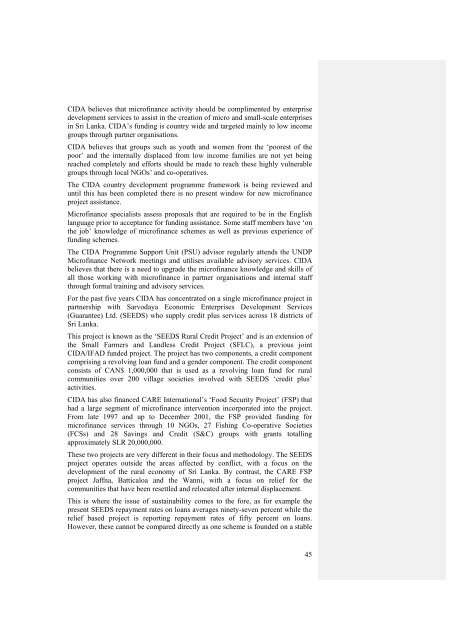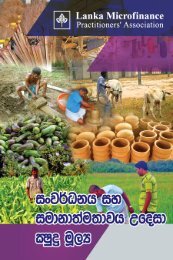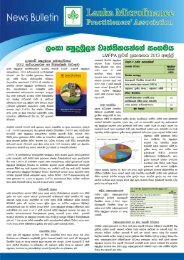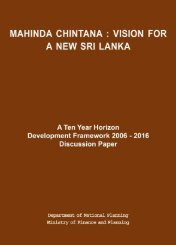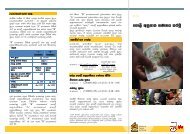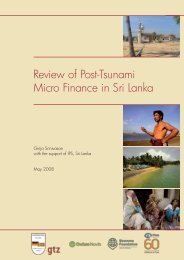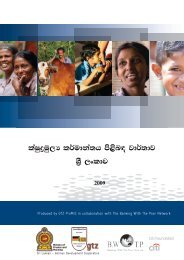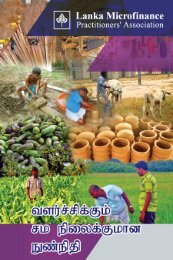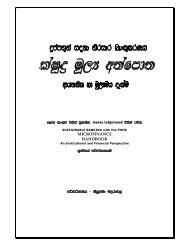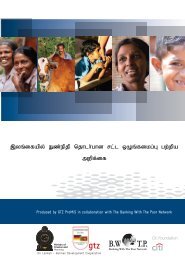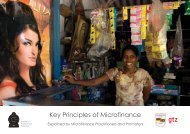National Microfinance Study of Sri Lanka: Survey of Practices and ...
National Microfinance Study of Sri Lanka: Survey of Practices and ...
National Microfinance Study of Sri Lanka: Survey of Practices and ...
You also want an ePaper? Increase the reach of your titles
YUMPU automatically turns print PDFs into web optimized ePapers that Google loves.
CIDA believes that micr<strong>of</strong>inance activity should be complimented by enterprise<br />
development services to assist in the creation <strong>of</strong> micro <strong>and</strong> small-scale enterprises<br />
in <strong>Sri</strong> <strong>Lanka</strong>. CIDA’s funding is country wide <strong>and</strong> targeted mainly to low income<br />
groups through partner organisations.<br />
CIDA believes that groups such as youth <strong>and</strong> women from the ‘poorest <strong>of</strong> the<br />
poor’ <strong>and</strong> the internally displaced from low income families are not yet being<br />
reached completely <strong>and</strong> efforts should be made to reach these highly vulnerable<br />
groups through local NGOs’ <strong>and</strong> co-operatives.<br />
The CIDA country development programme framework is being reviewed <strong>and</strong><br />
until this has been completed there is no present window for new micr<strong>of</strong>inance<br />
project assistance.<br />
<strong>Micr<strong>of</strong>inance</strong> specialists assess proposals that are required to be in the English<br />
language prior to acceptance for funding assistance. Some staff members have ‘on<br />
the job’ knowledge <strong>of</strong> micr<strong>of</strong>inance schemes as well as previous experience <strong>of</strong><br />
funding schemes.<br />
The CIDA Programme Support Unit (PSU) advisor regularly attends the UNDP<br />
<strong>Micr<strong>of</strong>inance</strong> Network meetings <strong>and</strong> utilises available advisory services. CIDA<br />
believes that there is a need to upgrade the micr<strong>of</strong>inance knowledge <strong>and</strong> skills <strong>of</strong><br />
all those working with micr<strong>of</strong>inance in partner organisations <strong>and</strong> internal staff<br />
through formal training <strong>and</strong> advisory services.<br />
For the past five years CIDA has concentrated on a single micr<strong>of</strong>inance project in<br />
partnership with Sarvodaya Economic Enterprises Development Services<br />
(Guarantee) Ltd. (SEEDS) who supply credit plus services across 18 districts <strong>of</strong><br />
<strong>Sri</strong> <strong>Lanka</strong>.<br />
This project is known as the ‘SEEDS Rural Credit Project’ <strong>and</strong> is an extension <strong>of</strong><br />
the Small Farmers <strong>and</strong> L<strong>and</strong>less Credit Project (SFLC), a previous joint<br />
CIDA/IFAD funded project. The project has two components, a credit component<br />
comprising a revolving loan fund <strong>and</strong> a gender component. The credit component<br />
consists <strong>of</strong> CAN$ 1,000,000 that is used as a revolving loan fund for rural<br />
communities over 200 village societies involved with SEEDS ‘credit plus’<br />
activities.<br />
CIDA has also financed CARE International’s ‘Food Security Project’ (FSP) that<br />
had a large segment <strong>of</strong> micr<strong>of</strong>inance intervention incorporated into the project.<br />
From late 1997 <strong>and</strong> up to December 2001, the FSP provided funding for<br />
micr<strong>of</strong>inance services through 10 NGOs, 27 Fishing Co-operative Societies<br />
(FCSs) <strong>and</strong> 28 Savings <strong>and</strong> Credit (S&C) groups with grants totalling<br />
approximately SLR 20,000,000.<br />
These two projects are very different in their focus <strong>and</strong> methodology. The SEEDS<br />
project operates outside the areas affected by conflict, with a focus on the<br />
development <strong>of</strong> the rural economy <strong>of</strong> <strong>Sri</strong> <strong>Lanka</strong>. By contrast, the CARE FSP<br />
project Jaffna, Batticaloa <strong>and</strong> the Wanni, with a focus on relief for the<br />
communities that have been resettled <strong>and</strong> relocated after internal displacement.<br />
This is where the issue <strong>of</strong> sustainability comes to the fore, as for example the<br />
present SEEDS repayment rates on loans averages ninety-seven percent while the<br />
relief based project is reporting repayment rates <strong>of</strong> fifty percent on loans.<br />
However, these cannot be compared directly as one scheme is founded on a stable<br />
45


